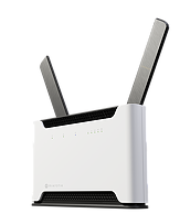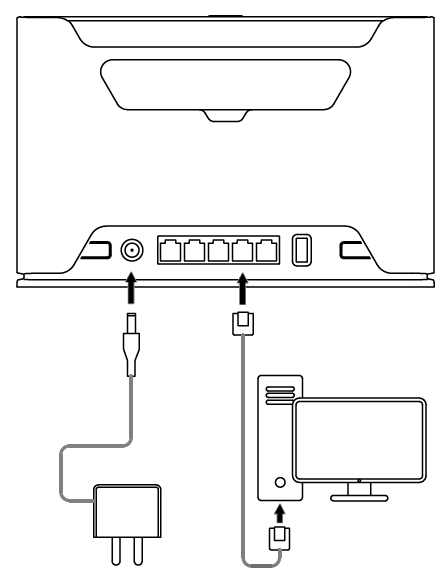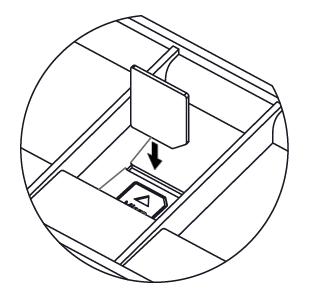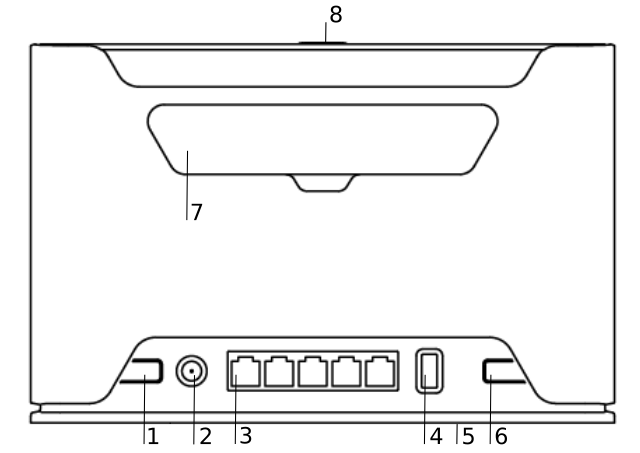Chateau LTE18 ax (S53UG+5HaxD2HaxD-TC&EG18-EA)
Safety Warnings
Before you work on any equipment, be aware of the hazards involved with electrical circuitry, and be familiar with standard practices for preventing accidents.
Ultimate disposal of this product should be handled according to all national laws and regulations.
The Installation of the equipment must comply with local and national electrical codes.
Failure to use the correct hardware or to follow the correct procedures could result in a hazardous situation for people and damage to the system.
This product is intended to be installed indoors. Keep this product away from water, fire, humidity, or hot environments.
Use only the power supply and accessories approved by the manufacturer, which can be found in the original packaging of this product.
Read the installation instructions before connecting the system to the power source.
We cannot guarantee that no accidents or damage will occur due to the improper use of the device. Please use this product with care and operate at your own risk!
In the case of device failure, please disconnect it from power. The fastest way to do so is by unplugging the power plug from the power outlet.
It is the customer's responsibility to follow local country regulations, including operation within legal frequency channels, output power, cabling requirements, and Dynamic Frequency Selection (DFS) requirements. All Mikrotik radio devices must be professionally installed.
Exposure to Radio Frequency Radiation: This MikroTik equipment complies with the FCC, IC, and European Union radiation exposure limits set forth for an uncontrolled environment. This MikroTik device should be installed and operated no closer than 20 centimeters from your body, occupational user, or the general public.
Quickstart
Please follow these quick steps to set up your device:
- Connect external antennas to the SMA connector (The antennas are provided in the package, see "Antenna usage");
- Insert a micro SIM card into the slot located under the device, the SIM card is not provided with the package;
- Connect the device to the power source;
- Connect to the device through either one of the Ethernet ports or the wireless network "MikroTik-..." (ensure to check the wireless passwords on the sticker);
- Establish a connection using a mobile application. Alternatively, use WebFig in a web browser or the "WinBox" configuration tool at https://mt.lv/WinBox; multiple configuration methods are available to ensure accessibility;
- Start configuration within the chosen tool, using the default IP address 192.168.88.1. If the IP address is unavailable, use WinBox and choose the "Neighbors" tab to find the device;
- Proceed to connect using the MAC address. The username is "admin", and there is no password (or, for some models, check user and wireless passwords on the sticker);
- Click the "Check for updates" button and update RouterOS to the latest version. A valid SIM card must be inserted or an eSIM set up, along with an active Internet connection, for updates to work;
- For a manual update of the device, visit the products page at https://mikrotik.com/products to find your product. The required packages are accessible under the "Support&Downloads" menu;
- Upload downloaded packages to the WebFig or WinBox "Files" menu and reboot the device;
- By upgrading your RouterOS software to the latest version, you can ensure optimal performance, stability, and security updates;
- In the "QuickSet" menu set up the following: Choose your country, to apply country regulation settings;
- Set up your wireless network password in the left field;
- Set up your router password in the bottom field.
Connecting with a mobile app
Use your smartphone to access your router through WiFi.
- Insert the SIM card and power it on the device.
- Scan the QR code with your smartphone and choose your preferred OS.
- Connect to the wireless network. SSID starts with MikroTik and has the last digits of the device's MAC address.
- Open application.
- By default, the IP address and user name will be already entered.
- Click Connect to establish a connection to your device through a wireless network.
- Choose Quick setup and the application will guide you through all basic configuration settings in a couple of easy steps.
- An advanced menu is available to fully configure all necessary settings.
Expansion slots and ports
- Reset button.
- Powering DC jack 2.0 mm.
- Five Gigabit ports, supporting automatic cross/straight cable correction (Auto MDI/X). Either straight or crossover cables can be used for connecting to other network devices.
- USB type-A.
- SIM slot for Micro sim card.
- Mode button.
- A cover for an external SMA antenna connector is not provided for models with antennas.
- WPS Sync button.
- Product code S53UG+5HaxD2HaxD-TC&EG18-EA.
- CPU Quad-Core IPQ-6010 1.8 GHz.
- CPU architecture ARM 64bit.
- Size of RAM 1 GB.
- RAM type DDR3L.
- Storage 128 MB, NAND.
- A number of 1G Ethernet ports 4.
- A number of 2.5G Ethernet ports 1.
- Micro SIM slots 1.
- USB 1 USB 3.0 type A.
- Switch chip model IPQ-6010.
- Wireless interface model QCN-5022 (2.4 GHz), QCN-5052 (5 GHz).
- Wireless 2.4 GHz 802.11ax dual-chain, 5 GHz 802.11ax dual-chain.
- Wireless antenna max gain 2.4 GHz (3 dBi), 5 GHz (6 dBi).
- LTE category 18 (1.2Gbps Downlink, 150Mbps Uplink).
- LTE modem EG18-EA.
- TAC 86981604.
- LTE antenna gain 4 dBi.
- LTE FDD bands 1 (2100MHz) / 3 (1800MHz) / 5 (850MHz) / 7 (2600MHz) / 8 (900 MHz) / 20 (800MHz) / 28 (700MHz).
- LTE TDD bands 38 (2600MHz) / 40 (2300MHz) / 41 (2500MHz).
- 3G Category R8 (42.2Mbps Downlink, 11.2Mbps Uplink).
- 3G Bands 1 (2100MHz) / 3 (1800MHz) / 5 (850MHz) / 8 (900MHz).
- Dimensions 240 x 156 x 44 mm.
- Operating system RouterOS v7, License level 4.
- Operating temperature -40°C to +65°C.
Mounting
The device is designed to be used indoors, by placing it on the desktop.
We recommend using CAT5 shielded cable. When using and installing this device please pay attention to the Maximum Permissible Exposure (MPE) safety distance with a minimum of 20 cm between the radiator and your body.
Powering
- A number of DC inputs 1.
- DC jack input Voltage 12-28 V.
- Power adapter nominal voltage 24 V.
- Power adapter nominal current 1.2 A.
- Max power consumption without attachments 16 W.
- Max power consumption 19 W.
Configuration
Configuration can be done using a web browser via WebFig, the WinBox tool https://mt.lv/WinBox, or a Mobile app. Multiple methods are available to ensure accessibility.
To access WebFig, open http://192.168.88.1 in your browser.
For WinBox, download the tool, go to the Neighbors tab, and click on the MAC address.
The default username is "admin", please find the password on the device sticker.
We recommend checking for updates frequently to ensure your RouterOS software remains up to date for the best performance and stability. Click the "Check for updates" button in WinBox or WebFig to update to the latest version.
A valid SIM card must be inserted or an eSIM set up, along with an active Internet connection, for updates to work.
RouterOS provides a wide range of configuration options beyond what's described in this document. We suggest visiting https://mt.lv/help to explore these features.
For recovery purposes, it is possible to boot the device for reinstallation, see section Buttons and Jumpers.
Mode button
The mode button is located on the back of the unit, on the right side.
The Default configuration for the Mode button is dark mode - to turn off all LEDs. The button can be configured in RouterOS to run any user-specified scripts.
Sync button
The sync button is located on the top of the unit. The WPS Sync button, if configured on the wireless interface, can be used to connect new clients.
- Press and hold the WPS button for 1 – 5 seconds to enable WPS for wireless interfaces.
Front LED status
- Wireless network activity.
- Ethernet port activity.
- System LED.
- Signal strength.
Cellular connection technology based on the System LED color:
Red: GSM
Yellow: 3G
Blue: LTE
Green: 5G NSA
Violet: 5G SA
When LTE is not connected to the network, the system LED will blink red to indicate that there is some issue with the LTE connection. If the LTE interface is intentionally disabled (not being used), the system LED will glow blue.
SIM slot usage
SIM card slot is designed to use with Micro SIM cards.
Nano SIM cards have different thicknesses, usage with an adapter is not recommended.
Reset button
The reset button has three functions:
- Hold this button during boot time until the green LED light starts flashing, release the button to reset RouterOS configuration (total 5 seconds).
- Keep holding for 5 more seconds, LED turns solid, release now to turn on CAP mode. The device will now look for a CAPsMAN server (total of 10 seconds).
- To reinstall RouterOS using the Netinstall utility, enter the device into BOOTP mode. There are two types of booters available: the regular booter and the backup booter.
- Regular booter - Power on the device, wait 1-2 seconds, then press and hold the Reset button. Wait until the System LED is blinking green, then turns solid "On". When the green LED turns "Off", release the Reset button - the device will enter BOOTP mode.
- Backup booter – Power off the device, press and hold the Reset button, then power it on. Wait until the System LED is blinking green, then solid "On". When the green LED turns "Off", release the Reset button - the device will enter BOOTP mode using the backup booter.
Regardless of the above option used, the system will load the backup RouterBOOT loader if the button is pressed before power is applied to the device. Useful for RouterBOOT debugging and recovery.
Netinstall
When performing Netinstall, make sure to use the latest v7 version of both RouterOS. Updating your RouterOS software to the latest version will ensure the best performance, stability, and security updates.
Accessories
The package includes the following accessories that come with the device:
- ADAPT1_ EU/US Switching Power Supply 24V, 1.2A.
- CAB3_ CAT5E UTP Flat Cable, 8P8C, AWG32, 1.5m.
Antenna usage
SMA connectors are for LTE antennas.
External antenna sockets are located on the back of the device. Device comes with connected wireless antennas, LTE antennas are not provided within the package.
Operating system support
The device supports RouterOS software version 7 and higher. The specific factory-installed version number is indicated in the RouterOS menu /system resource. Other operating systems have not been tested.







